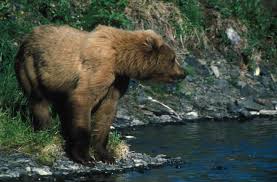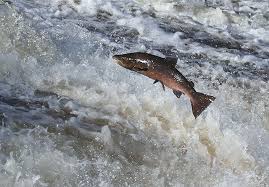Being rich in what matters, like integrity, relationships, health and spirituality — in a culture obsessed with money and stuff — is like being a salmon.
Salmon make a hero’s journey. They swim upriver 700 perilous miles and more to return to their birthplaces, spawn and produce the next generation of wild salmon.
Not by coincidence, salmon flesh is incredibly nutritious. The unique potlatch ceremonies of Pacific Northwest Indians, in which the more you gave away to others the more status you gained, was based largely on the wealth that the salmon created for the tribes. (I think I like their definition of status.)
Oral legend is that before white men arrived, the salmon runs were so thick that you could cross the rivers by walking on their backs. I shiver inside whenever I picture that. Here are the song lyrics I wrote that use that image of indigenous salmon runs.
We can make heroes’ journeys in our own lives. Here are seven ways that we can live like the courageous, iconic fish of the Pacific Northwest.
1. Be resilient in different environments. Salmon thrive in both freshwater rivers and the briney ocean environment. They are anadromous, Their bodies and behaviors change and adapt, depending on where they are. We can do the same. Here is more on how to be resilient.
2. Accept that we’re going upstream. A hero’s journey is not the path of least resistance. Mainstream culture will whisper to us that we need only ease and endless convenience to have good lives. That’s a lie, and believing it weakens and even imprisons us.
How to best travel upstream? We humans have feet rather than fins and we walk more than we swim. So, climbing is my favorite analogy. Here are tips I’ve used to climb a couple of the tallest mountains in Oregon. In my last climb I gasped for air like a fish out of water, ha ha. But keeping the ways of salmon in mind, I persevered to the top.
3. Don’t worry overmuch about eating. Notice I said overmuch. I encourage all of us to eat well (here are my tastiest, healthiest, simplest menus).
Mainstream culture, though, makes eating into a fetish. It seduces us with endless food and beverage ads, and the siren’s notion that life is about sating ourselves with food and drink. The result of all that seduction is a national obesity epidemic that compromises our health, which is the very foundation of being rich in what matters.
Salmon swimming upstream don’t focus on eating. In fact, they eventually stop eating altogether, similar to people wrapping up their final days on earth. The mouths of some male salmon even stiffen into an open curve, called a kype, that makes them unable to eat. They keep swimming upstream anyway.
We have to eat in order to live, and it’s fine to enjoy it. But we don’t have to live in order to eat. Instead, we can stay focused on our hero’s journey.
4. Find pools in which to rest during our hero’s journey. It takes great energy to swim upstream, and no creature can do it ‘round the clock. Salmon go the distance by periodically finding quiet pools in which to rest and regather their strength.
Your resting-pool might be a low-key assignment in your current job. Or it might be a period of unemployment in which you regroup, and become more clear on your life-purpose and career direction. For parents, a finally-empty nest may be a resting-pool. Many college students take some time off from school before completing their degree (I did).
The place you choose to rest, though, makes a big difference. Are you resting in a bear’s fishing-hole? Evaluate your environment carefully before settling in.

Bears are beautiful, but they catch and eat a lot of salmon. Case our your resting-pool carefully before relaxing.
5. If you hit a dam, find a ladder to climb up and through. Many dams in salmon country have fish ladders built into them so that the salmon can climb up past the dam. You can see fish ladders and salmon traveling through at the Bonneville Dam, on the Oregon side of the Columbia River.
Your ladder through your dam might be a mentor who encourages you when you’re about to give up. It could be an unexpected article or website that gives you breakthrough information, or shows you a workaround. Ladders are everywhere. A resting pool may help us to slow down and focus carefully enough to spot them.
6. Return to your home. This is the startling, unique signature of the salmon. Returning home is an insanely inconvenient thing to do. If the salmon would just lay their eggs a stone’s throw upriver from the ocean, everything would be so much easier.
But then there would be no hero’s journey. The passionate, pure-hearted, even irrational insistence on the long, hard journey home is what makes a salmon a salmon.
Perhaps we need to faithfully go home to visit our parents, trips that change dramatically over the years as they age, and need more support from us. Honoring our elders is crucial. Thor and I are making one of these trips next month.
But your hero’s journey of returning home might be metaphorical, not literal. Living like a salmon may mean returning to — or discovering — your spiritual center, or what your spirit originally came here to the earth to do. Many great books and movies are about this kind of returning home. Here are some good books I recommend.
7. Live a good story. Salmon don’t live a story of ease and comfort. I sigh as I write this, because I like comfort. I’m sipping strong coffee with cream, sugar and cinnamon as I write. But at least I am currently winning the battle against my nemesis Haagen Dazs.
The hard truth is that salmon live a story of challenge, of swimming upstream. And their almost miraculously rich, deep pink flesh feeds the Northwest ecosystem, including a hell of a lot of humans.

Mother Teresa lived like a salmon.
If salmon were people, they would be hanging out with people like Mahatma Gandhi, Mother Teresa and Dr. Martin Luther King, Jr. They would get together for coffee, no cream or sugar or cinnamon, and then all go climb Mount Hood together, raising a few million dollars to feed the hungry and battle climate change in the process. Me, I would be lucky to serve as their first-world Sherpa. Here is more on living a good story.
How do you relate, or not relate, to the idea of life as a hero’s journey? Have you ever encountered any salmon in the wild?
To enter the drawing for a free 541 Threads t-shirt, become a subscriber to Diamond-Cut Life. You’ll receive a post each Thursday on how to be rich in what matters, plus a Monday post announcing the new Threads winner. Just leave a comment telling me you’re entering. Double-check your email address since it’s the only way I can tell you that you won.
photos courtesy of www.geograph.org and public domain images.




October 24, 2014
Love, love, love this! Thanks for the insight!
October 25, 2014
Kris, I love hearing this from you.
October 24, 2014
Great essay!
Please enter me in the Threads drawing, too.
October 25, 2014
Gladly, Jenny.